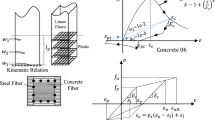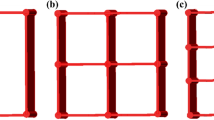Abstract
A model to predict bending stiffness of oriented strandboard (OSB) was tested with pilot plant experimental data. The experimental procedure developed in this study is unique in that it allows the model to be tested for extensive vertical configurations of strand angle distribution. After validation, the model was used to simulate a typical three-layer cross-oriented OSB panel with a vertical density profile and strand angle distribution measured on industrial panels. Analysis of the simulated vertical distribution of modulus of elasticity (MOE) indicated that the layers near the panel surfaces contributed much more to the effective parallel panel MOE than those close to the panel thickness center, with 80% of parallel MOE coming from the top 41% of weight and 32% of thickness. The effectiveness of methods to increase parallel bending stiffness through improving mat structure was evaluated. Increasing face/core weight ratio from 54/46 to 66/34 resulted in a 3.7% increase in simulated parallel MOE. Alignment of strands in face layers was identified having a greater potential to increase parallel MOE. Simulations with three improved strand angle distributions showed gains of 5.7, 12.0 and 19.8% in parallel MOE compared with a typical strand angle distribution of industrial OSB panels.







Similar content being viewed by others
References
Barnes D (2000) An integrated model of the effect of processing parameters on the strength properties of oriented strand wood products. Forest Prod J 50(11/12):33–42
Barnes D (2002) Orientation of OSB and particleboard strands for high-strength oriented strand lumber and panel products. Forest Prod J 52(9):31–39
Bodig J, Jayne BA (1982) Mechanics of wood and wood composites. Van Nostrand Reinhold Company, New York
Chen S, Wellwood R (2002) Nondestructive evaluation of oriented strandboard. In: Proceedings of the 13th international symposium on nondestructive testing of wood, University of California, Berkeley, 19–21 August 2002
Forest Products Laboratory (1999) Wood handbook––wood as an engineering material. Forest Products Laboratory, Madison, pp 4–29
Geimer RL (1976) Flake alignment in particleboard as affected by machine variables and particle geometry. U.S.D.A. Forest Products Laboratory Research Paper No. FPL 275
Geimer RL (1979) Data basic to the engineering of reconstituted flakeboard. In: Proceedings of the thirteenth Washington State University international symposium on particleboard, Pullman, Washington, April 1979, pp 105–125
Grant D (1997) Effets De La Distribution De L’orientation Des Particules De Couches Extérieures Sur Les Propriétés ∼Mécaniques Des Panneaux De Particules Orientées. MSc Thesis, LAVAL University, Canada
McNatt JD, Bach L, Wellwood R (1992) Contribution of flake alignment to performance of strandboard. Forest Prod J 42(3):45–50
Moses DM, Prion HGL, Li H, Boehner W (2003) Composite behavior of laminated strand lumber. Wood Sci Technol 37:59–77
Painter GJ, Budman H, Pritzker M (2006) Prediction of oriented strandboard properties from mat formation and compression operating conditions. Part 2: MOE prediction and process optimization. Wood Sci Technol 40:291–307
Saliklis EP, Falk RH (2000) Correlating off-axis tension tests to shear modulus of wood-based panels. J Struct Engrg ASCE 126:621–625
Xu W (1999) Influence of vertical density distribution on bending modulus of elasticity of wood composite panels: a theoretical consideration. Wood Fiber Sci 31:277–282
Xu W (2000) Influence of percent alignment and shelling ratio on modulus of elasticity of oriented strandboard: A model investigation. Forest Prod J 50(10):43–47
Xu W, Suchsland O (1998) Modulus of elasticity of wood composite panels with a uniform density profile: a model. Wood Fiber Sci 30:293–300
Author information
Authors and Affiliations
Corresponding author
Rights and permissions
About this article
Cite this article
Chen, S., Fang, L., Liu, X. et al. Effect of mat structure on modulus of elasticity of oriented strandboard. Wood Sci Technol 42, 197–210 (2008). https://doi.org/10.1007/s00226-007-0167-0
Received:
Published:
Issue Date:
DOI: https://doi.org/10.1007/s00226-007-0167-0




